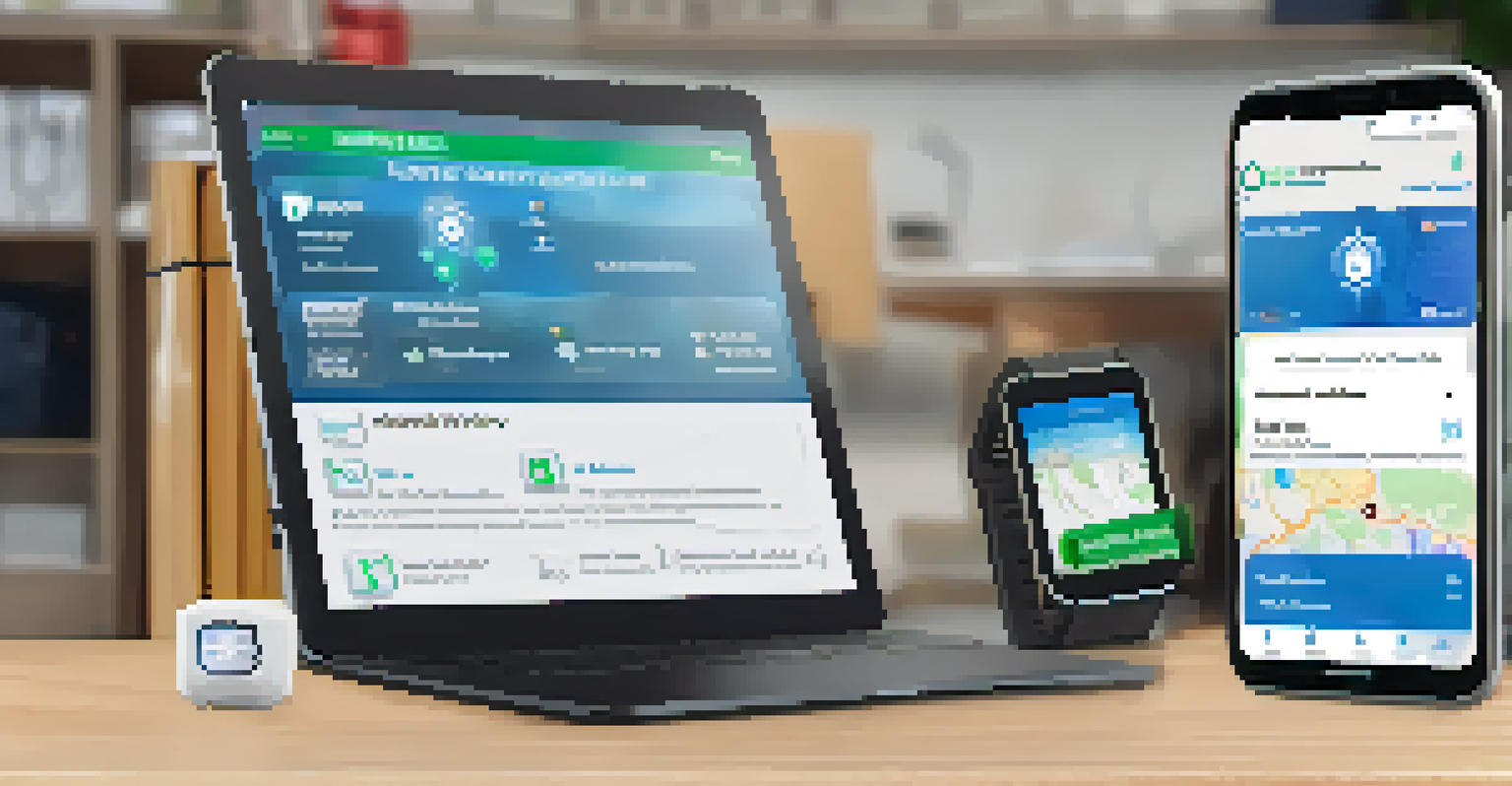Emergency Preparedness for Remote Workers: A Quick Guide

Understanding the Importance of Emergency Preparedness
Emergency preparedness is crucial for everyone, including remote workers. When working from home, you might think you’re safe from disasters, but emergencies can strike anywhere. Whether it's a natural disaster, a medical emergency, or a power outage, being prepared can make all the difference. Understanding why preparation is vital is the first step in ensuring your safety and productivity.
By failing to prepare, you are preparing to fail.
Imagine a scenario where a severe storm knocks out your power while you're in the middle of an important project. Without a plan, you might find yourself scrambling to find backup solutions. But with proper preparedness, you can minimize downtime and stress. This proactive approach not only keeps you safe but also helps maintain your workflow during unexpected events.
Incorporating emergency preparedness into your routine can empower you as a remote worker. It’s not just about having supplies; it’s about creating a mindset that prioritizes safety and readiness. By taking the time to understand the importance of being prepared, you’re setting yourself up for success, no matter what challenges arise.
Creating a Home Emergency Plan
A home emergency plan is your roadmap to safety when disaster strikes. Start by identifying potential risks in your area, such as floods, earthquakes, or fires. Once you know what to prepare for, outline the steps you’ll take in each scenario. This could include evacuation routes, communication plans, and emergency contacts that are easily accessible.

Involve your household in the planning process to ensure everyone knows their role. For instance, assign tasks like gathering supplies or checking in on each other during an emergency. Practice your plan regularly, just like a fire drill, so that everyone feels confident and prepared. This proactive approach not only strengthens your plan but also fosters teamwork and communication.
Emergency Plans Ensure Safety
Creating a comprehensive home emergency plan helps you and your family respond effectively during crises.
Keep your emergency plan visible by posting it on your fridge or near your workspace. This way, you can quickly reference it during an emergency. Remember, the more prepared you are, the less panic you'll feel if something goes wrong. Having a clear plan can truly be the difference between chaos and control.
Stocking Up on Emergency Supplies
When it comes to emergencies, having the right supplies can be a lifesaver. Start by creating a checklist of essential items like water, non-perishable food, flashlights, batteries, and a first-aid kit. Aim for a supply that can last at least 72 hours, as this is often the critical time frame for assistance to arrive. Remember to include any personal medication or supplies that you might need.
An ounce of prevention is worth a pound of cure.
Consider your remote work needs as you stock up. For example, having backup chargers for your devices can be invaluable during a power outage. A portable phone charger can keep you connected even when the power is out. Think about what specific items would help you maintain your work routine while ensuring your safety.
Regularly check your supplies to ensure everything is up-to-date and functional. Rotate items like food and batteries to avoid spoilage. By being proactive in stocking your emergency supplies, you’ll feel more secure and confident in your ability to handle any situation that arises.
Establishing a Communication Plan
In an emergency, effective communication is key. Establish a communication plan that outlines how you and your family or coworkers will stay in touch during a crisis. Identify primary and secondary methods of communication, such as phone calls, text messages, or social media. This ensures that everyone knows how to reach each other, even if one method fails.
Consider setting up a group chat or using apps designed for emergencies that can keep everyone informed. Regularly update your contacts about your safety and whereabouts, especially if you live alone. This not only provides peace of mind to your loved ones but also helps you stay connected and supported during stressful times.
Regular Drills Build Confidence
Practicing emergency drills regularly prepares everyone for real-life situations, fostering a culture of readiness.
Remember to include emergency contacts in your communication plan. These should be individuals who can assist you in a crisis, whether it’s a neighbor, friend, or family member. By establishing a clear communication strategy, you can enhance your overall preparedness and ensure that support is always just a message away.
Utilizing Technology for Emergency Preparedness
Technology can be a powerful ally in emergency preparedness. Utilize apps designed to keep you informed about local emergencies, weather alerts, and safety tips. Many of these apps can send real-time notifications, helping you stay one step ahead. By leveraging technology, you can turn your smartphone into a vital tool for safety and information.
Consider setting up automatic alerts for severe weather or local emergencies. This way, you’ll receive timely updates that can help you make informed decisions. Additionally, consider using cloud storage to keep important documents and contacts accessible from anywhere. In an emergency, having your information readily available can save you valuable time and stress.
Don't forget to back up your data regularly, as power outages or system failures can disrupt access to your files. By integrating technology into your emergency plan, you’re not just enhancing your preparedness; you’re also ensuring that you're equipped to respond effectively when unexpected situations arise.
Training and Drills: Practice Makes Perfect
Just like fire drills at school, practicing your emergency plan is vital. Regular drills help everyone know what to do and where to go in a crisis. Schedule drills at least twice a year to keep everyone familiar with the procedures. This practice reinforces the plan and builds confidence, turning uncertainty into preparedness.
Involve your family or housemates in these training sessions. Consider simulating different scenarios, like a fire or an earthquake, to see how well your plan holds up. This hands-on approach will highlight any weaknesses in your plan, allowing you to make necessary adjustments. Plus, it can be a bonding experience, turning a serious topic into a fun and engaging activity.
Stay Informed About Local Hazards
Being aware of local risks and staying updated on emergency alerts equips you to respond quickly when disasters strike.
Remember, preparedness is not a one-time task but an ongoing commitment. The more you practice, the more prepared you’ll be when it really matters. By making drills a regular part of your routine, you’ll foster a culture of readiness that empowers everyone involved.
Staying Informed About Local Hazards
Being aware of local hazards is essential for effective emergency preparedness. Research potential risks in your area, such as floods, wildfires, or earthquakes. Understanding what could impact you allows you to tailor your emergency plan accordingly. This knowledge equips you to respond quickly and effectively when faced with a disaster.
Stay updated on local news and weather reports to receive timely information. Many communities offer alerts and notifications regarding emergencies; sign up for these services to stay in the loop. Knowledge is power, and being informed can help you make critical decisions quickly, ensuring your safety and that of your loved ones.

Engage with your community to learn more about local preparedness initiatives. Many organizations provide resources and training that can enhance your readiness. By staying informed about local hazards, you’re not just protecting yourself; you're also contributing to a culture of safety within your community.
Reflecting on Your Preparedness Journey
Emergency preparedness is an ongoing journey, not a one-time checklist. After implementing your emergency plan, take time to reflect on what worked and what didn't. This reflection allows you to continuously improve your strategies, ensuring that you’re always ready for the unexpected. A flexible mindset can make a significant difference in your overall preparedness.
Engage with others to share experiences and tips. Joining local community groups or online forums can provide valuable insights and resources. Hearing about others’ challenges and solutions can inspire you to enhance your own preparedness efforts. Remember, you’re not alone in this journey; there’s a whole community of people working towards the same goal.
Finally, celebrate your progress. Acknowledge the steps you've taken to prepare for emergencies, no matter how small. Each step counts, and recognizing your efforts can motivate you to keep going. By reflecting on your preparedness journey, you’re reinforcing the importance of being ready for whatever life throws your way.